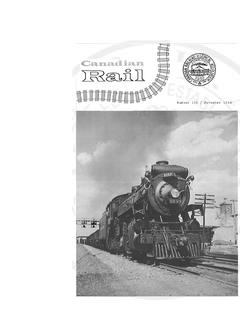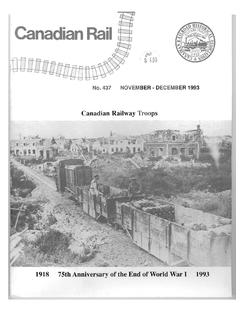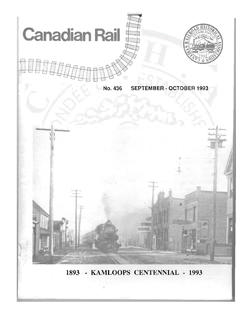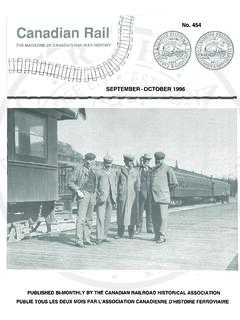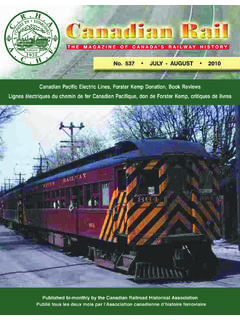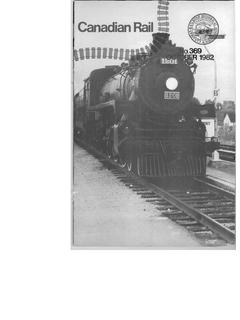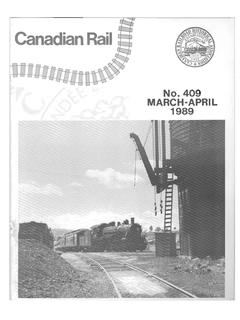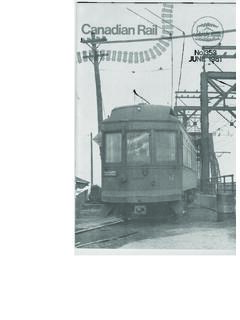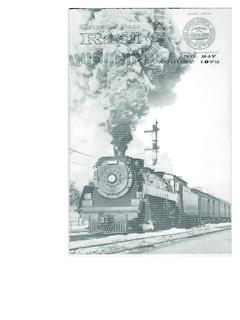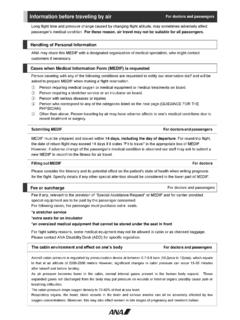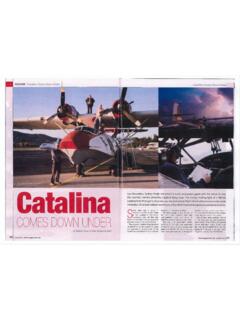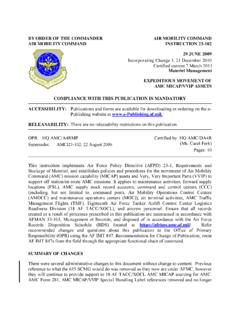Transcription of Canadian Rail no311 1977 - Exporail
1 Canadian rail No. 311 DECEMBER 1977 / OPPOSITE: An electric suburban train of the New South Wales railway system southbound across the famed Sydney Harbour bridge, ~eading for Sydney's main railway station on January. 7, 1976. The intermixing of single and double decker cars is typical of this operation, as is the policy of running with car doors open during the summer months in order to provide better ventila-tion. The harbour bridge carries extensive rail traffic bound for Sydney's northern suburbs. I COVER: Three Melbourne trams of class "W2" are depicted in this view taken January 7, 1976. Car 601 (foreground) was built in 1930, while cars 323 (centre) and 418 (rear) were built in 1925 and 1927 respectively, and were formerly of class "W" before being converted to "W2" about 1930. Since the 1920's cars of this design have been the mainstay of the Melbourne fleet, and many are still in daily service after more than half a century of continual us e.
2 IAN 1551'1 0006 -4675 Published monthly by The Canadian Railroad Historical Association Box 22, Station B Montreal Quebec Canada H3B 3J5 EDITOR: M. Peter Murphy EDITOR EMERITUS: S. S. Worthen BUSINESS CAR: John Welsh LAYOUT: Michel Paulet CALGARY & SOUTH WESTERN L. M. Unwin, Secretary 1727 23rd Ave. , Calgary Alberta T2M lV6 OTTAWA D. E. Stoltz, Secretary P. O. Box 141, Station A, Ottawa, Ontario K1N 8Vl PACIFIC COAST R. Keillor, Secretary P. O. Box 1006, Station A, Vancouver British Columbia V6C 2Pl ROCKY MOUNTAIN C. K. Hatcher, Secretary P. O. Box 6102, Station C, Edmonton Al berta T5B 2NO TORONTO & YORK DIVISION J. C. Kyle, Secretary P. O. Box 5849, Terminal A, Toronto Ontario M5W lP3 WINDSOR-ESSEX DIVISION R. Ballard, Sr., Secretary 300 Cabana Road East, Windsor, Ontario N9G lA2 'D-,-own rail Mike Riedel n~emantle , a s'ettin g.
3 , - was the end' ,is .port for the 1 g:aug~ tra i 0 sendc-e Kilometre. away is the unti l the f of Af .. -" ". ~.~.~ . ~~ . '"" Where in the world can one: Ride a first class stain-less steel passenger train sporting individual showers 1n each bedroom? Ride a subway, connected with a main line railway, where the car doors are routinely left open when running? Visit a city with more than six hundred street cars in service, varying in age from one month to 56 years? Ride a mixed train as one means of entering this nation's capital city? Observe three different track gauges still in regular use? Travel continuously for 478 Km. (297 miles) without a single curve? If you c51~~(s t ion sis , of ,.,it ,;t-'tj'e n t" 0 r "Do~1n ;;.:';1)(6i~\t i nteres t i ng ,,'.;'.-Ji}i' !!1 to ex p lore . have not guessed by now, the answer to all these course, Australia, also known as the "Fifth Con-Under", ,and the location tif surely some of the and diversified railways a rail fan could possibly.)
4 :~ , >:~~~4;i. This narrative deals with the explorations of two Canadian railfans flying in from around the world in opposite directions and meeting by prearrangement in Sydney as the start of a fifteen day rail expedition. In 1975, the Railways of Australia introduced the "Austrail Pass" by which a non-resident of that country may obtain unlimited first class rail travel for a given period of time at a greatly reduced rate. Accordingly, we each provided ourselves with a 14-day Austrail Pass (available from Cook's travel agency) costing $ Australian (about $ Canadian ) each, and de-cided that we would start for Asutralia on January 2, 1976. Hence, both of us left our respective jobs on that date, Fred flying from Montreal via Vancouver, Tahiti and Fiji, while Mike flew from Bremen, Germany via Frankfurt, Bahrain and Singapore.
5 Both of us arrived in Sydney within four hours of each other in the midst of the Australian summer, a great contrast to the frigid Northern-hemisphere winter we had just left. After suitably adjusting to the ten-hour jet lag, and depositing our excess baggage with Fred's cousin Heather, our first priority was to attempt to book space on the "Indian Pacific", Australia's crack transcontinental train, departing from Sydney four times weekly for Perth, 3961 Km. (2461 miles) and 66 hours away. Having heard that one must book at least six months ahead to be guaranteed space in this peak travel season, we were highly skeptical as we approached the ticket office in Sydney's Central station. However, to our surprise we were able to obtain a "Twinette" (double bedroom) from Sydney to Perth for January 8, only three days later! A cut-away model of a roomette car used on the "Southern Aurora".
6 The all-sleeper train between Sydney and Melbourne. Of special interest is the "zig-zag" corridor arrangement which allows more efficient utilization of space and makes the roomette more com-fortable. However. the shape of the corridor necessitates a lit-tle more care when walking through the train. The "Southern Aurora" at Melbourne's Spencer Street Station on January 7, 1976, ready to depart on the overnight run to Sydney. The train has been preceded by tIle "Spirit of Progress" which leaves from the same track one hour before. Victorian Railways locomotive S309 will take the "Aurora" as far as the New South Wales border, where a locomotive of the railway will take over for the rest of the trip. A train of electric suburban cars running at full speed through the outskirts of Melbourne on the morning of January 7, 1976.
7 As in Sydney, summer operation with doors open is usual. The "Red rattlers" which, despite their age, appear in excellent condition, show a curious blend of North American and British construction. The buffers give a somewhat European look to the train, so dif-ferent from modern long-distance trains such as the "Southern Aurora" . Canadian 364 R A I L What could be done during these intervening three days? First, of course, was a ride on Sydney's underground railway sys-tem (subway) which is operated by the Hew South Wales Railways. This system connects with and is compatible with the main-line railways serving Sydney's outlying districts. Here, the custom is for tickets to be collected upon exiting, however a little fast talking permitted us to keep these as souvenirs. During the remainder of the day we inspected the terminals and part of the railway yards, and then sought locations for photographing a few of the numerous passenger trains in motion.
8 Unquestionably, one of the best vantage points was from the sidewalk of the world-famous Sydney Harbour Bridge, where an almost continual flow of suburban passenger trains affords many opportunities to photograph the varied types of equipment. This ranges all the way from half-century-old wooden cars (since retired following a bad wreck) to modern stainless-steel by-levels. Having seen a portion of what Sydney had to offer, we then boarded the "Southern Aurora" bound for Melbourne. This all-stainless-steel sleeping car train was introduced in 1962 when a standard-gauge 1435 mm. (4'8,") line was built into Melbourne to allow a through run from Sydney, eliminating the change of gauge at Albury which had required passengers to change trains in the middle of the night ever since the lines of New South Wales and Victoria first met in June, l8H3.
9 The state of Victoria, of which Melbourne is the capital, uses a gauge of 1600 mm. (5'3"), which of course is incompatable with the standard gauge used in New South Wales. Overnight service between Sydney and Melbourne is provided by the "Southern Aurora" and the "Spirit of Progress", the latter carrying coaches as well as sleepers and departing an hour before the "Aurora". Upon arrival in Melbourne's Spencer Street station, we set out to see the city. Melbourne is the only city in the South-ern hemisphere to have retained its extensive tram network vir-tually intact, and, of course, a ride on some of these cars was an obvious must. Melbourne's electric tram system dates only from 1906, as previously service was provided by cable cars which ran on a 73 Km. (46 mile) system. However, the early electric cars supplimented but did not replace cable cars, and cable cars were built as late as 1924: Some cable car operation survived until 1940, when the last line was replaced by buses.
10 Surpris-fngly enough, however, 15 years later, this bus line was itself replaced by electric street cars: One grip car and trailer car (the latter built by John Stephenson Co. of New York in 1885) have b~en preserved and are on display in downtown Mel-bourne, as reminders of the almost 1200 cable cars that once ran through that city's streets. Despite the fact that the main-line Victorian railways are broad gauge, the Melbourne trams are standard gauge. There are more than 600 trams in service, all double-ended two-man cars. The oldest date back to 1921, while the newest were still being delivered in 1976. All but the most recent lot are painted green with cream trim, and carry numbers between 101 and 1041. The new cars are orange and cream, and numbered from 1 upwards. At the time of our visit the numbers had reached the 20's, but eventual-ly there will be 100 of this new design which will replace the oldest trams now in service.
